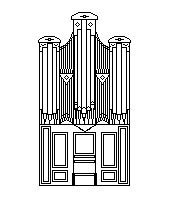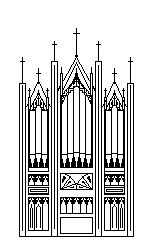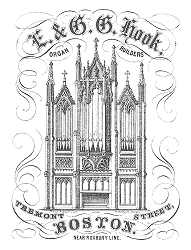|
The story of the Hook firm is similar to that of many other successful businesses established in the nineteenth century. The company began locally, expanded over time, and eventually became one of the most prominent organ-building firms in the country. Like many other firms of the period, they exhibited their organs at industrial expositions, they placed organs in homes, churches and civic halls -- and they published advertising materials. One of their final publications of the nineteenth century was an "opus list," giving the location and general size of each of their organs.220 We can look at this chronological report of their activity and learn a lot about the development of the firm and its instruments. Fortunately some of their earlier work survives, and we can compare the reality with the sometimes self-serving description from the end of the century.
Location
Although their organs were eventually built for concert halls, lodge halls, and private homes, all instruments the Hooks built before 1860 were meant for use in worship, so you will find them only in churches, temples and college chapels. Where the architecture allowed it, they were placed in a gallery, but many were placed at the main floor level. The acoustics varied, as you might expect, with the size and ornateness of the room. Most small instruments were placed in small, plain rooms, with hard surfaces which helped the sound rather than harmed it.
Disposition
In general, early Hook organs were based on English instruments, so that a typical two-manual instrument had a disposition based on this pattern:
- On the Great
- an 8' Open Diapason and an 8' Stopped Diapason.
- an 8' string (Viol or Dulciana)
- a 4' Principal, 2 2/3' Twelfth, and a 2' Fifteenth to make up an English chorus with the two Diapasons
- a 4' Flute
- a Mixture
- a Trumpet
- On the Swell
- an 8' Open Diapason and an 8' Stopped Diapason
- a 4' Principal and a 2' Fifteenth
- a 4' Flute
- a Sesquialtera III
- a reed, usually an Oboe ("Hautboy")
- In the Pedal
- a 16' Bourdon or Subbass
- an 8' Violoncello
This basic plan was subject to change, of course, but it should give you a basis from which to consider specific stoplists. Here are some of the more common variants.
- Some instruments had a Clarabella, a open wood flute, on one of the manuals. This was a new American stop, and one brochure published by the Hooks indicates they invented it.226
- Another common stop was the "Unison Bass" or "Common Bass," twelve stopped wooden pipes that played only in the first octave. This stop provided the first octave of pipes for either the Stopped Diapason, the Clarabella, or perhaps a string -- stops whose pipes did not extend into the bottom octave at all. This economical arrangement not only saved in the total number of pipes that were made for instruments, it also conserved space by providing a single set of pipes where full-compass ranks would have required two or three.
- Larger instruments would have a Choir division. This division was normally unenclosed, in contrast to the similar divisions you may have encountered on later instruments. Its stops usually included
- An 8' Stopped Diapason
- An 8' Dulciana or Viol, in addition to an open flute (Clarabella or Melodia)
- a 4' Principal, a 4' Flute, and possibly a 4' String
- an 8' Clarinet (usually "Clarionet")
- You might think the 8' Pedal stop listed above is a string, but it was usually a small-scaled principal, with a mild tone. Larger instruments might have a 16' Open Diapason (usually wood) as well. Only the largest instruments would have a 16' pedal reed.
Compass
The compass of the typical Hook organ of the period was derived from English models, and you will find many of their earliest instruments with a G-compass Great, a Swell that began on g (even though the lower keys might be present), and a Pedal of one and a half octaves, also beginning on G. By the middle of the century -- still during the first twenty-five years of building organs -- the G-compass was abandoned and the C-compass we know was adopted. The straght, flat pedalboard, which was the normal design for both England and the continent before the nineteenth century, was also found on Hook organs. In some cases, even before 1860, they replaced it with the curved radiating pedalboard we know today, an adaptation of Henry Willis's innovation in console design.225 They continued to build the flat pedalboards through the end of the century, however.
Tonal Characteristics
The sound of the Great chorus was generally direct and bright, with some "sweetness" in a smaller-scaled Swell. Consider this list of descriptions, taken from testimonials published by the Hooks in a brochure of 1857.227
- An article in Dwight's Journal of Music, on the new organ in the Tremont Temple, then the largest organ in the country:
- "... the Diapasons of the grand Organ, which are remarkably round, and rich, and musical."
- A letter (1857) from Thomas M. Clark, Bishop of Rhode island:
- "The elements of power and delicacy are wonderfully harmonized, ..."
- A letter (1857) from the Trustees of Clinton Avenue Congregational Church, Brooklyn:
- For full volume of sound, and the rich, pure tone of its more delicate stops, we think it excells any Organ that we have heard in our 'City of Churches,' ..."
- "Your reputation for excelling in reed stops, is fully sustained in this Organ."
- A letter (1840) from a committee of three organists [identified in the source] to the Committee of St. Luke;'s Church, Philidelphia:
- "The general tone of the instrument is brilliant and powerful, ..."
- "The pedals are possessed of great body and depth of tone, ..."
- "The trumpet in the great Organ is of great power, majesty and purity; the clarionet and claribella in the swell are of a very high order of merit. The peculiar character of the claribella differing from the stops of the same name in other instruments is very striking. The diapasons of the great Organ are distinguished for richness and body of tone, and the wooden open diapason is deserving of special notice. All the reed stops are remarkable for their purity and for the promptness with which they speak."
- A letter (1841) from J. C. B. Stanbridge, professor of Music and Organist, to the Wardens and Vestry of St. Phillips' Church, Philadelphia:
- "The pedal pipes are of an unusually large scale, producing a grand and noble bass."
Mechanical Characteristics
Instruments made before 1860 were without exception mechanical-action organs. Small instruments without pedals had a foot-operated lever that could be pumped by the player to provide wind to the pipes. Others had a hand-operated bellows, with the handle for pumping the organ usually located at one of the rear corners of the case. Stop controls were conveniently-placed draw-knobs arranged in a single row above the manual keyboards or divided on either side of the keyboards on larger organs. The usual arrangement of the knobs was in a series of horizontal rows, much like the typical consoles built by Cavaillé-Coll during the same period.
Appearance
 The earliest Hook organs were housed in cases similar to those by English builders of the same period, or by other American builders such as Thomas Appleton or William Goodrich. Remember, the Hook brothers began by working with him, so we might expect their instruments to have some similarities there. The drawing to the right shows the essential characteristics: The earliest Hook organs were housed in cases similar to those by English builders of the same period, or by other American builders such as Thomas Appleton or William Goodrich. Remember, the Hook brothers began by working with him, so we might expect their instruments to have some similarities there. The drawing to the right shows the essential characteristics:
- A rather solid-looking shape, with sides that extend straight down from the impost to the floor.
- Three towers, the largest in the center.
- Flats separating the towers.
The drawing shows two-story flats, but in a smaller instrument these would be only one story. The first organ E. and G. G. Hook built was a one-manual organ that is now in the Essex Institute in Salem, Massachusetts. Even this small instrument, with only a handful of stops, has this basic shape.224 Larger instruments didn't add additional flats and towers to the sides -- they simply made the flats and towers themselves wider.
 After only a few years, another basic case design emerged -- the one you see in the drawing to the left. This design is based on a flat façade divided into three sections. This particular drawing is derived from the one on the front of the 1857 brochure mentioned in the preceding section and pictured at the top of this page. But don't let the Gothic decoration fool you -- that's not the essential part of the design here. Place your mouse pointer over the drawing, and you'll see another "elevation" replace this one. It has a different aspect, but it was also based on a drawing in a Hook publication.228 The basic shape is the same -- three sections divided by structural elements of the case -- but the decorative elements are different. This basic shape of three sections would remain an essential element of design in organs by E. and G. G. Hook, by Hook and Hastings, and by other builders for the remainder of the century. When you look at large or small instruments, in home, church or civic hall, look for this three-part division of the façade. After only a few years, another basic case design emerged -- the one you see in the drawing to the left. This design is based on a flat façade divided into three sections. This particular drawing is derived from the one on the front of the 1857 brochure mentioned in the preceding section and pictured at the top of this page. But don't let the Gothic decoration fool you -- that's not the essential part of the design here. Place your mouse pointer over the drawing, and you'll see another "elevation" replace this one. It has a different aspect, but it was also based on a drawing in a Hook publication.228 The basic shape is the same -- three sections divided by structural elements of the case -- but the decorative elements are different. This basic shape of three sections would remain an essential element of design in organs by E. and G. G. Hook, by Hook and Hastings, and by other builders for the remainder of the century. When you look at large or small instruments, in home, church or civic hall, look for this three-part division of the façade.
Conclusion
This page should give you an idea of what sort of answers you might expect when you read some of the pages on individual instruments from early nineteenth-century North America. Most of them in this tutorial are instruments by E. & G. G. Hook, but some were built by other firms operating at the same time in other parts of the country. Regardless of who built the organs, however, you can use some of the information on this page to guide you as you read about pre-Civil War organs in the United States.
|


 The earliest Hook organs were housed in cases similar to those by English builders of the same period, or by other American builders such as Thomas Appleton or William Goodrich. Remember, the Hook brothers began by working with him, so we might expect their instruments to have some similarities there. The drawing to the right shows the essential characteristics:
The earliest Hook organs were housed in cases similar to those by English builders of the same period, or by other American builders such as Thomas Appleton or William Goodrich. Remember, the Hook brothers began by working with him, so we might expect their instruments to have some similarities there. The drawing to the right shows the essential characteristics: